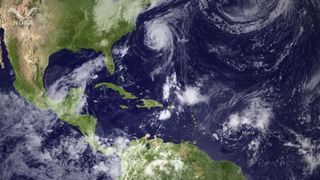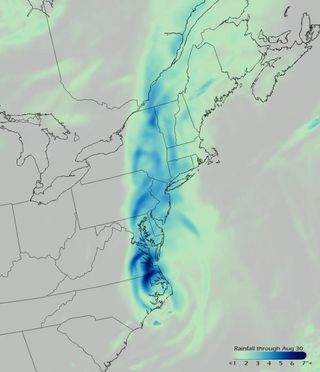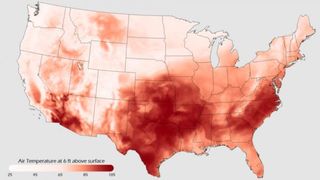
Stormy Summer Had Everything from Deluges to Drought

Monster snowstorms were the big news of winter. The spring brought a deadly, record-setting tornado season and epic flooding. Not to be outdone, summer saw plenty of extreme weather of its own: hurricanes, heat waves, drought and wildfires.
With La Niña's return, the fall could be wild as well. Before the start of autumn this Friday (Sept. 23), here's a look back at the harsh summer that was.
Hurricane
When Hurricane Irene made landfall on North Carolina's Outer Banks, it became the first hurricane to hit the United States in nearly three years.
An active hurricane season has slowed down in recent days, but more storms are forecast for the late season in fall. So far there have been 14 named storms (which include tropical storms as well as hurricanes),three hurricanes and two major hurricanes (Irene and Katia).
Predictions had called for this season to be a doozy, with 14 to 19 named storms, seven to 10 hurricanes, and three to five major hurricanes (Category 3 or higher).
Irene came dangerously close to dealing a serious blow to New York City. It devastated New Jersey, upstate New York and Vermont with severe flooding. The storm became 2011's 10th billion-dollar weather disaster.
Sign up for the Live Science daily newsletter now
Get the world’s most fascinating discoveries delivered straight to your inbox.

The summer's hurricane season also had several uncommon happenings. The leftovers of Hurricane Katia blew through Britain Sept. 12, an unusual occurrence that brought the strongest winds the United Kingdom has seen in nearly 15 years.
Canada also had some hurricane action. Hurricane Maria hit Newfoundland Sept. 16. Canada is hit by hurricanes more often than you'd think. More than a dozen have affected the Avalon Peninsula, where the province's capital, St. John's, is located, and where Maria hit.

Oppressive heat
Texas had the warmest summer for any state going back to 1895, according to the National Climatic Data Center. The state's average temperature was 86.8 degrees Fahrenheit (30.4 degrees Celsius). Neighboring Oklahoma and Louisiana had the second- and fourth-warmest summers of any state, respectively.
Wichita Falls, Texas, had 100 days of 100-degree Fahrenheit heat (38 degrees Celsius), a new state record. Dallas set its own city record for most 100-degree days in a year with 70.
The hot, hot heat wasn't limited to Texas. A July heat wave affected some 200 million people in the United States.
No state in the union was safe from the blistering heat that month, according to the National Climatic Data Center. Preliminary data showed 2,712 high-temperature records were tied or broken in July, compared with 1,444 last year, according to the NCDC. At least one weather station in all 50 states set or tied a daily high temperature record at some point during July.
Newark set an all-time high at 108 F (42.2 C) on July 22, breaking the 10-year-old record of 105 F (40.6 C). That same day in Washington, D.C., Dulles International Airport recorded its highest July temperature of all time, at 105 F (40.6 C).

Drought
As if the heat wasn't bad enough, the Southwest received no rainfall to speak of. June to August was the driest summer on record in Texas, with only 2.44 inches of precipitation falling on average.
Texas' current drought is the most severe one-year drought on record, according to Texas State Climatologist John Nielsen-Gammon of Texas A&M University. Levels of extreme (81 percent) and exceptional (14 percent) drought in Texas affected 95 percent of the state's area, according to the Drought Monitor at the University of Nebraska-Lincoln.
The drought hasn't been confined to Texas. Nearly one-fifth of the contiguous United States is in the grip of extreme drought.
Wildfires
The hot and dry weather created dangerous fire conditions. Nearly 18,612 wildfires have burned 3.5 million acres of Texas so far this year, according to the Texas Forest Service. That's about the size of Connecticut.
Six of the state's 10 largest wildfires came during 2011. The damage was estimated at more than $5 billion.

Flooding
While the Southwest continued its arid streak, the Upper Midwest continued to see severe flooding.
Melting of an above-average snowpack across the northern Rocky Mountains, combined with above-average precipitation, caused the Missouri and Souris rivers to swell beyond their banks across the Upper Midwest.
An estimated 11,000 people were forced to evacuate Minot, N.D., due to the record high level of the Souris River. Numerous levees were breached along the Missouri River, flooding thousands of acres of farmland. The flooding, which is ongoing, has caused more than $2 billion in damages.
The Mississippi River flooding of the spring also spilled into summer. Persistent rainfall (nearly triple the normal precipitation amounts in the Ohio Valley), combined with melting snowpack, caused historical flooding along the Mississippi and its tributaries. The region suffered $2 billion to $4 billion in losses. At least two people died.
Cold
The summer also saw a couple of odd cold records. The temperature in the "Nation's Icebox," International Falls, Minn., dipped to 19 F (minus 7 C) on Sept. 15, the town's first-ever temperature in the teens for the month of September, according to the National Weather Service. [Related: The Coldest Places on Earth]
s the summer in Canada neared its end, Edmonton, Alberta, finally saw its last pile of snow melt. The last holdout drift was a patch of snow at Edmonton's west end snowstorage facility, where plows dump snow scooped from city streets. The last snowflake finally melted late in the afternoon of Sept. 10.
- The World's Weirdest Weather
- The Most Extreme Environments on Earth
- Weirdo Weather: 7 Rare Weather Events
Follow OurAmazingPlanet for the latest in Earth science and exploration news on Twitter @OAPlanet and on Facebook.

